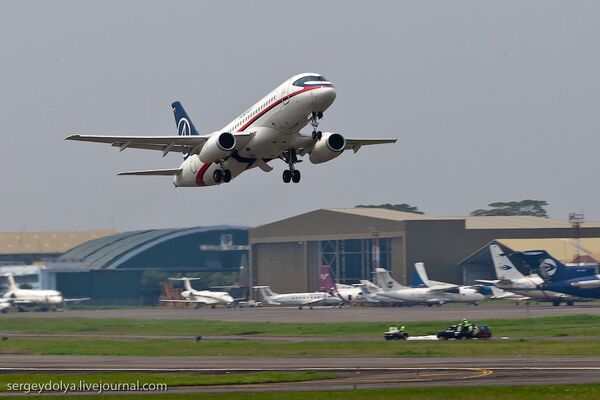The crash site of the Sukhoi Superjet-100 (SSJ-100) that disappeared in Indonesia on May 9 has been found. It had crashed into a mountain. However, the tragic end of the demo flight does not spell the end of this Russian civil aviation project.
Steep slope
The Russian Superjet 100 airliner, serial number 95004, disappeared from radar screens while performing a demonstration flight in Indonesia, south of Jakarta. The aircraft was returning to the airfield when contact with it was lost.
The plane’s emergency beacons were dead. Therefore, several versions of the incident were investigated, including hijacking. This was the only hope left when the aircraft ran out of fuel.
All hope was lost on the morning of May 10 when search and rescue helicopter spotted scattered debris on the steep wooded slope of the Salak volcano. The plane seemed to have been pulverized.
According to latest reports, there were 45 people onboard the aircraft, of whom eight were Russians, including crew members and Sukhoi employees. No survivors have been reported.
Russian airliner with regional ambitions
The RRJ (Russian Regional Jet) project to develop the Sukhoi Superjet 100 airliner (available in two models: regular and extended range, both with 75 or 95 passenger seats), was launched in the early 2000s.
A dedicated company, Sukhoi Civil Aircraft was established for this project, which contracted many foreign companies. Mikhail Pogosyan, then head of the Sukhoi company and now president of the United Aircraft Building Corporation, was the man behind this project.
The project was on and off until the first flight took place in May 2008, and deliveries to customers began in 2011. The airliner is manufactured at the main Sukhoi factory in Komsomolsk-on-Amur and is positioned as a new Russian design.
The level of the innovations that went into the aircraft and the commercial viability of the project are debatable. Opinions differ, and it is difficult for Sukhoi to be up to par with established competitors manufacturing regional aircraft like Brazilian Embraer and Canadian Bombardier.
China tried its hand at making regional aircraft recently, which isn’t making things easier for Sukhoi. Chinese aircraft may not be of better quality than the one made by key players, but it is definitely cheaper.
The Russian origin of the aircraft, however, is questionable. In fact, construction materials, fuselage elements, and a set of auxiliary equipment is all there is Russian in it. French SaM-146 engines also were designed jointly with the Saturn research-and-production association. Almost everything else is foreign-made including avionics, electrical system, control systems and even the auxiliary power unit.
The Superjet has acquired a bad reputation, embodied by its nickname PopilJet, which implies lots of kickbacks and other fraudulent financial activities. It’s easy to understand the skeptics: The national high-tech industry has had too few successes since 1991, especially in the aviation industry.
The civil aviation industry was particularly hard hit, which was further compounded by lack of funding. There were many aircraft designs, but not many survived. In fact, there are just two of them: The Sukhoi Superjet that had just rolled off the assembly line and the promising MS-21 made by Irkut Corporation, which has not made a single flight yet. It’s very unlikely that anything else will come up in the near future.
The disbursement of allocated funds turned into a bitter fight.
The crash and the future
There is an “aberration of proximity” effect when what you see on a regular basis day in and day out becomes very important and fateful. Any failure appears to be an irreparable tragedy.
Here is a recent example: the word “Bulava” has become synonymous with failure, and yet there is nothing supernatural about unsuccessful missile tests. There have been even worse tests, but such stories never made it on the news, let alone had crowds of witnesses as in December 2009 when people in northern Norway witnessed a spiralling phenomenon of inexplicable nature in the dark of the night.
Things are similar with aircraft. The Superjet is going into mass production. It is being frantically finalized but there are still plenty of crudely designed parts and unresolved problems. However, one crash (remember, it is still unclear why it occurred, quite possibly because of pilot error) doesn’t mean a lot. Clearly, we are in for an avalanche of reporting, which, in one way or another, will try to bury the Superjet project.
A relatively recent story comes to mind. On June 26, 1988, a European airliner just out of the design bureau brushed treetops and crashed during a demonstration flight. This also caused a flurry of gossip and skepticism regarding its fate. Twenty-four years later there are almost 2,800 A320 airliners available in all its models; 2,700 more have been ordered, not including related A318, A319 and A321 models.
So, the crash in Indonesia, while tragic, can to a certain extent be considered a routine occurrence. There’s no doubt that the Superjet has a bright future.
However, its future depends on the powers-that-be in the domestic aviation industry, including those that report to Mikhail Pogosyan and those that he is accountable to.
The views expressed in this article are the author's and may not necessarily represent those of RIA Novosti.

